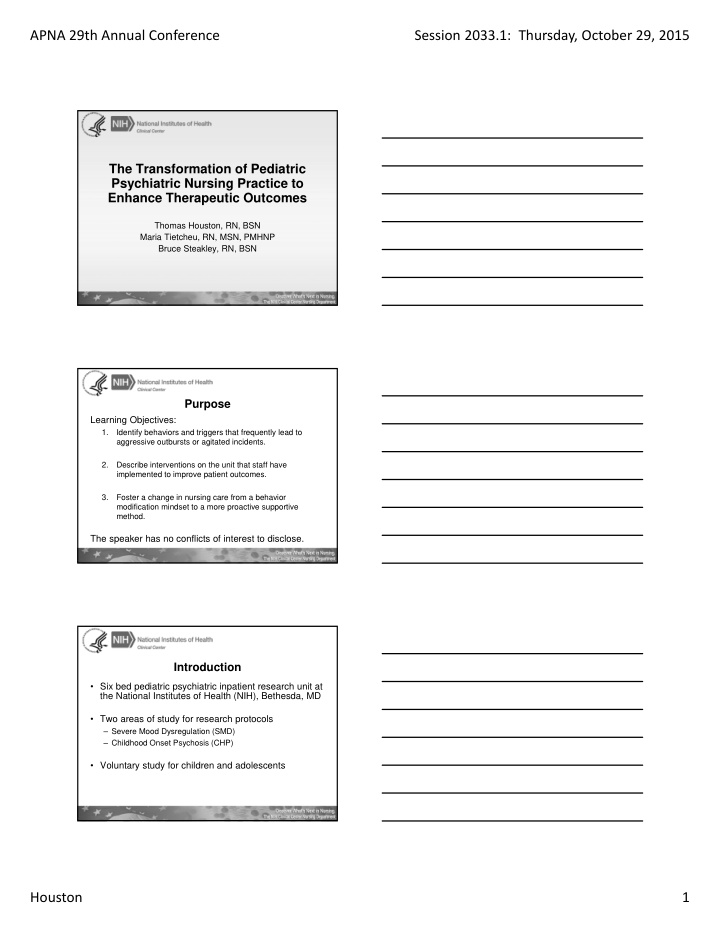



APNA 29th Annual Conference Session 2033.1: Thursday, October 29, 2015 The Transformation of Pediatric Psychiatric Nursing Practice to Enhance Therapeutic Outcomes Thomas Houston, RN, BSN Maria Tietcheu, RN, MSN, PMHNP Bruce Steakley, RN, BSN Purpose Learning Objectives: 1. Identify behaviors and triggers that frequently lead to aggressive outbursts or agitated incidents. 2. Describe interventions on the unit that staff have implemented to improve patient outcomes. 3. Foster a change in nursing care from a behavior modification mindset to a more proactive supportive method. The speaker has no conflicts of interest to disclose. Introduction • Six bed pediatric psychiatric inpatient research unit at the National Institutes of Health (NIH), Bethesda, MD • Two areas of study for research protocols – Severe Mood Dysregulation (SMD) – Childhood Onset Psychosis (CHP) • Voluntary study for children and adolescents Houston 1
APNA 29th Annual Conference Session 2033.1: Thursday, October 29, 2015 Research Process • Screening protocol • Admission to the unit • Medication taper/medication free phase • Diagnosis formulation: appropriate for study? • Study protocol – Study medication – Data gathering • Discharge process Evolution of Our Practice What We Did What We Do • Establish unit rules • Unit guidelines, maintain flexibility • Determine safe or not safe • Determine patient needs/ capabilities • Seclusion or restraint • Quality time, relationships • Respond to aggression • Interpret aggression as an expression of need • Take control • Give control • Categorize by diagnosis • Symptom profile • Negative Reinforcement • Advocate • Stereotype • Understand neurobiology • Exclusion • Therapeutic relationships • React, Watch • Anticipate, Observe • Follow rules/schedules • Recognize transitions Case Study • Patient A, 2005 • Patie nt B, 2015 • Nursing Style: Rigid • Nursing Style: Strength based, behavior modification skill focused, and supportive • Reacted to his behavior • Anticipated his needs • Overestimated his • Symptom profile created to capacity determine capacity • Inappropriate expectations • Set small, realistic, achievable set him up for failure goals with immediate reward Houston 2
APNA 29th Annual Conference Session 2033.1: Thursday, October 29, 2015 Triggers That Lead To Aggressive Outbursts • Saying “no” • Transitions • Time alone • Family and peer interactions • School • Lack of structure • Asking beyond their capacity • Past experience with seclusion and restraint Current Nursing Interventions • Developing a symptom profile • Identifying the patients capacity • Weighing patient needs vs. staff/unit needs • Developing and communicating individualized patient care plans • Engaging in partnered relationships • Providing one to one staff to patient care as indicated Accommodations Utilized Percentage Used During Stay 2013/2014 1:1 order 23.17 Limited Group Activities 5.77 Extra Staff Presence During Transitions 16.18 6.42 Supervised ADL's Staff Presence Until Asleep 9.76 Staff Assistance with Family Contact 4.76 Reduced Stimulation 24.44 Structured Room Time with Staff Present 13.79 Separate Meals/Activities/Planning/Free-Time 7.87 Meals in Room 8.93 Assist with Menus 12.51 Peer Relationship Negotiating 13.25 Structured Room Time 12.1 Other 3.08 0 5 10 15 20 25 30 Houston 3
APNA 29th Annual Conference Session 2033.1: Thursday, October 29, 2015 Enhanced Therapeutic Outcomes Seclusions and Restraints per Actual Patient Days 0.50% 0.40% 0.30% 0.26% 0.24% 0.20% 0.17% 0.16% 0.10% 0.00% 0.00% 2010 2011 2012 2013 2014 NIH Implications for Future Practice • Changing the mindset from reactive to proactive nursing care • Recognizing behaviors that lead to aggressive outbursts • Providing supportive interventions • Improve staff to patient ratio References • American Psychiatric Nurses Association. (2014). Position Statement: The Use of Seclusion and Restraint. Retrieved from http://www.apna.org • Hert, M. D., Dirix, N., Demunter, H., & Correll, C. U. (2011). Prevalence and Correlates of Seclusion and Restraint use in Children and Adolescents: A Systematic Review. European Child & Adolescent Psychiatry, 20, 221 ‐ 230. • Pogge, D. L., Pappalardo, S., Buccolo, M., & Harvey, P. D. (2013). Prevalence and Precursors of the use of Restraint and Seclusion in a Private Psychiatric Hospital: A Comparison of Child and Adolescent Patients. Administration and Policy in Mental Health, 40, 224 ‐ 231. • Valenkamp, M., Delaney, K., & Verheij, F. (2014). Reducing Seclusion and Restraint During Child and Adolescent Inpatient Treatments: Still an Underdeveloped Area of Research. Journal of Child and Adolescent Psychiatric Nursing, 27, 169 ‐ 174. Houston 4
Recommend
More recommend